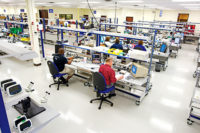One of the most important resources in manufacturing, even in the age of automation, is people. Ergonomically designed workstations for workers mean higher performance, work quality, motivation and employee satisfaction, as well as fewer absences due to injuries.
In short: A strong understanding of ergonomics is a huge plus for productivity, efficiency and employee happiness.
These eight ergonomic principles cover the most essential aspects of the layout and design of ergonomic workstations and flow rack systems.
Consider Body Height and Working Height
Manual workstations must accommodate a wide range of body heights. However, one of the most important factors for designing workstations is working height. The optimum working height is based on the body height and the type of activity to be performed. If you take all body heights into consideration, the average optimum working height for most tasks is 1,125 millimeters for sit-down and stand-up workstations.
Ensure Proper Lighting
The right light, adapted to the activity at the workstation, is a prerequisite for high efficiency and processing quality. Optimum lighting prevents premature fatigue, improves concentration, and reduces the risk of errors. When installing lighting at workstations, try to avoid light that causes glare, reflection or strong contrasts.
Optimize Grab Area
Easy access to all the materials required at the workstation must be guaranteed. All containers, equipment and operating elements must be arranged within the physiological range of movement for employees to easily reach and grab what they need throughout their shift. One of the largest considerations for optimizing the grab area is to identify ways to avoid torso rotations and shoulder movements, particularly when under exertion, to reduce strain.
Customize Work Equipment
To maintain performance, promote productivity, and ensure workers are comfortable throughout their shift, workstations must be precisely adjusted to the individual employee and activity. Correct adjustment of the equipment minimizes unnecessary movements, thus reducing physical exertion and employee absences.
Optimize Work Area Height
The work area should always be between 800 and 1,500 millimeters high. Working above heart level (over 1,500 millimeters) and bending (below 800 millimeters) puts employees under disproportionate strain by impacting blood circulation and reducing oxygen supply to the muscles. Promoting dynamic activities, such as a combination of standing and sitting, is recommended, because static activity can cause strain.
Strategically Position Parts
All reach distances should be as short as possible to avoid unnecessary movements. Grab containers and parts containers that are in direct reach of the employee are ideal. The position of these containers should enable a flowing movement that curves upward away from the body when parts are removed. Consider storing heavy parts within reach in the lower containers and give frequently grabbed parts the shortest reach distance.
Consider Range of Vision
Unnecessary head and eye movements are a common cause of work strain and should be avoided as much as possible. Workers have two vision areas: field of view and visual field. The field of view is where workers can see something without moving their eyes or head. In the visual field, objects can be seen by moving the eyes. Maintaining objects at a uniform distance to the worker’s eyes eliminates the need for refocusing and makes it easier to complete tasks.
Use Planning Aids
Properly implementing ergonomic workstations can feel daunting with so many factors to consider throughout the process. Help make it easier by using planning aids like Bosch Rexroth’s MTproto design workstations. This user-friendly software accelerates and simplifies planning of application-specific workstations by adapting configurations for individual workers based on ergonomic best practices.







